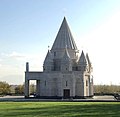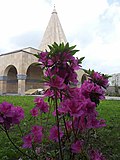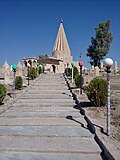| Name | Location | Image | Notes |
|---|
| Lalish temple | Nineveh Governorate, Iraq |  | The location of the tomb of the Sheikh Adi ibn Musafir, a central figure of the Yazidi faith and considered the holiest of Yazidi temples. [2] |
| Sharfadin temple | Sinjar, Iraq |  | 800 year old temple considered by Yazidis as one of the holiest places on earth. [3] Dedicated to Sherfedin. |
| Chel Mera (Chermera) or "40 Men" Temple | Mount Sinjar, Iraq |  | Considered one of the holiest of Yazidi temples, located on the highest peak in Sinjar mountains, Iraq [4] |
| Makan Sheikh Adi | Sinjar, Iraq |  | Located near Sardashte Camp on top of Mount Sinjar, where Shekh Adi visited before going to Lalish. |
| Ziarat temple | Aknalich, Armenia |  | Ziarat or Ziyarat temple is the first Yazidi temple in Armenia. It literally means "Pilgrimage Temple." The temple was consecrated in 2012. [5] |
| Quba Mêrê Dîwanê temple | Aknalich, Armenia |  | The world's largest Yazidi temple dedicated to the angel Melek Taus and the Seven Angels of Yazidi theology. The temple was consecrated in 2019. [5] |
| Shekhubekir (Şêxûbekir) temple | Rya Taza, Armenia |  | In December 2020, a Yezidi cleric from the Lalish holy site located in Iraq blessed a newly built temple named after Shekhubekir (Şêxûbekir) which is open to the public. |
| Bacin Temple | Güven (Bacin), Turkey |  | Temple in Güven, Midyat, Mardin Province, southeastern Turkey |
| Quba Haji Ali Temple | Ba'adra, Iraq |  | |
| Khiz Rahman Shrine | Baadre, Iraq |  | Shrine of Khiz Rahman in Baadre |
| Sultan Ezid Temple | Tbilisi, Georgia |  | Temple modelled on the Lalish temple, located in Tbilisi, Georgia. The temple was consecrated in 2015. [6] |
| Quba Xatuna Fexra | Mağara (Kiwex), Turkey |  | Quba Xatuna Fexra (Temple of Khatuna Fekhra) in Mağara, İdil, Şırnak Province, southeastern Turkey. Dedicated to Khatuna Fekhra. |
| Quba Pire Ewra | Sinjar, Iraq |  | Quba Pire Ewra ("Pir of the people") Temple in Sinjar, Iraq |
| Şexsê Batê | Babira, Iraq |  | Shrine of Shekhse Bate in Babera village, Iraq |
| Quba Sheikh Mand | Sinjar, Iraq |  | Shrine in the southern part of Sinjar, Iraq. Dedicated to Sheikh Mand. |
| Shrine of Nishingaha Peroz | Ain Sifni, Iraq |  | Ezidi shrine of Nishingaha Peroz near Ain Sifni, Duhok Governorate. [7] |
| Khatarah Temple | Khatarah, Iraq |  | |
| Dughata Temple | Dughata, Iraq |  | |
| Sreshka Temple | Sreshka, Iraq |  | |
| Khoshaba Temple | Khoshaba, Iraq |  | In Khoshaba, Iraq [8] |
| Malak Miran Temple | Bashiqa, Iraq |  | Dedicated to the angel Malak Miran, the temple is located about 9 miles east of Mosul, the temple was restored and reopened on 12 January 2018 after being destroyed by ISIL terrorists in 2014. [9] [10] |
| Shrine of Mohamed Rashan | Bardarash, Iraq |  | Shrine part of Yazidi temple complex on a mountainside facing the Erbil-Duhok road. [11] Dedicated to Mehmed Reshan. |
| Mam Rashan Shrine | Mount Sinjar, Iraq |  | Temple dedicated to Mam Rashan, a saint associated with agriculture, rain, and the annual harvest. [12] The temple is estimated to date back to the 12th century. [13] Dedicated to Mehmed Reshan. |
| Shebl Qasim Shrine | Sinjar, Iraq |  | |
| Pire Zirav Temple | Cinerya, Turkey |  | The location of the tomb is near Zewa Mira of Xalta |

























